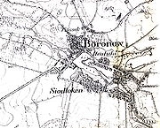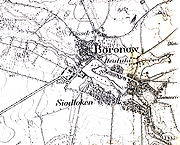
Boronów
Encyclopedia
Boronów AUD is a village
in Lubliniec County
, Silesian Voivodeship
, in southern Poland. It is (since 1993) the seat of the gmina
(administrative district) called Gmina Boronów
. It lies approximately 16 kilometres (10 mi) east of Lubliniec
and 47 km (29 mi) north of the regional capital Katowice
. it is on the Liswarta
river. The village has a population of 2,793. Between 1975 and 1998 it was in the former Częstochowa Voivodeship
.
The name Boronów originates from the coniferous forest
s (pl
bory) in the area or from the surname Boronowski, who was one of owners of this village. In old chronicles the names Borunow and Bornów are found. But on the herb of Boronów there is a harrow
, because it was a sign on the old village's stamp
.
 The written history of Boronów begins in the 13th century in documents of Casimir III
The written history of Boronów begins in the 13th century in documents of Casimir III
, but on that area wolder relicts from Neolithic
and Lusatian culture
were found by archeologist in the 1920s.
In 1611 a wooden church was founded by Andrzej Dzierżanowski, owner of Boronów.
In the 19th century the village belonged to Hohenlohe-Ingelfingen
's family. In this time it was an industrial village. On its area there were two mines of ore, two breweries
and a sawmill
. Both mines were the largest in the whole ziemia lubliniecka.
Village
A village is a clustered human settlement or community, larger than a hamlet with the population ranging from a few hundred to a few thousand , Though often located in rural areas, the term urban village is also applied to certain urban neighbourhoods, such as the West Village in Manhattan, New...
in Lubliniec County
Lubliniec County
Lubliniec County is a unit of territorial administration and local government in Silesian Voivodeship, southern Poland. It came into being on January 1, 1999, as a result of the Polish local government reforms passed in 1998. Its administrative seat and largest town is Lubliniec, which lies ...
, Silesian Voivodeship
Silesian Voivodeship
Silesian Voivodeship, or Silesia Province , is a voivodeship, or province, in southern Poland, centering on the historic region known as Upper Silesia...
, in southern Poland. It is (since 1993) the seat of the gmina
Gmina
The gmina is the principal unit of administrative division of Poland at its lowest uniform level. It is often translated as "commune" or "municipality." As of 2010 there were 2,479 gminas throughout the country...
(administrative district) called Gmina Boronów
Gmina Boronów
Gmina Boronów is a rural gmina in Lubliniec County, Silesian Voivodeship, in southern Poland. It was formed in 1993, having previously been part of Gmina Herby...
. It lies approximately 16 kilometres (10 mi) east of Lubliniec
Lubliniec
Lubliniec is a town in southern Poland with 29,359 inhabitants . It is the capital of Lubliniec County, part of Silesian Voivodeship ; previously it was in Częstochowa Voivodeship .-Geography:...
and 47 km (29 mi) north of the regional capital Katowice
Katowice
Katowice is a city in Silesia in southern Poland, on the Kłodnica and Rawa rivers . Katowice is located in the Silesian Highlands, about north of the Silesian Beskids and about southeast of the Sudetes Mountains.It is the central district of the Upper Silesian Metropolis, with a population of 2...
. it is on the Liswarta
Liswarta
The Liswarta is a river in south-central Poland, a tributary of the Warta river. The Liswarta has a length of 93 km and basin area of 1,588.-Towns and villages:* Gmina of Woźniki** Mzyki* Gmina of Boronów** Grojec** Boronów* Gmina of Herby...
river. The village has a population of 2,793. Between 1975 and 1998 it was in the former Częstochowa Voivodeship
Czestochowa Voivodeship
Częstochowa Voivodeship was a unit of administrative division and local government in Poland in years 1975–1998, superseded mainly by Silesian Voivodeship, with a few eastern gminas attached to the freshly created Świętokrzyskie Voivodeship...
.
The name Boronów originates from the coniferous forest
Forest
A forest, also referred to as a wood or the woods, is an area with a high density of trees. As with cities, depending where you are in the world, what is considered a forest may vary significantly in size and have various classification according to how and what of the forest is composed...
s (pl
Polish language
Polish is a language of the Lechitic subgroup of West Slavic languages, used throughout Poland and by Polish minorities in other countries...
bory) in the area or from the surname Boronowski, who was one of owners of this village. In old chronicles the names Borunow and Bornów are found. But on the herb of Boronów there is a harrow
Harrow (tool)
In agriculture, a harrow is an implement for breaking up and smoothing out the surface of the soil. In this way it is distinct in its effect from the plough, which is used for deeper tillage. Harrowing is often carried out on fields to follow the rough finish left by ploughing operations...
, because it was a sign on the old village's stamp
Seal (device)
A seal can be a figure impressed in wax, clay, or some other medium, or embossed on paper, with the purpose of authenticating a document ; but the term can also mean the device for making such impressions, being essentially a mould with the mirror image of the design carved in sunken- relief or...
.
History of Boronów

Casimir III of Poland
Casimir III the Great , last King of Poland from the Piast dynasty , was the son of King Władysław I the Elbow-high and Hedwig of Kalisz.-Biography:...
, but on that area wolder relicts from Neolithic
Neolithic
The Neolithic Age, Era, or Period, or New Stone Age, was a period in the development of human technology, beginning about 9500 BC in some parts of the Middle East, and later in other parts of the world. It is traditionally considered as the last part of the Stone Age...
and Lusatian culture
Lusatian culture
The Lusatian culture existed in the later Bronze Age and early Iron Age in most of today's Poland, parts of Czech Republic and Slovakia, parts of eastern Germany and parts of Ukraine...
were found by archeologist in the 1920s.
In 1611 a wooden church was founded by Andrzej Dzierżanowski, owner of Boronów.
In the 19th century the village belonged to Hohenlohe-Ingelfingen
Hohenlohe-Ingelfingen
Hohenlohe-Ingelfingen was a German County located in northeastern Baden-Württemberg, Germany, around Ingelfingen. Hohenlohe-Ingelfingen was a partition of Hohenlohe-Langenburg...
's family. In this time it was an industrial village. On its area there were two mines of ore, two breweries
Brewery
A brewery is a dedicated building for the making of beer, though beer can be made at home, and has been for much of beer's history. A company which makes beer is called either a brewery or a brewing company....
and a sawmill
Sawmill
A sawmill is a facility where logs are cut into boards.-Sawmill process:A sawmill's basic operation is much like those of hundreds of years ago; a log enters on one end and dimensional lumber exits on the other end....
. Both mines were the largest in the whole ziemia lubliniecka.

